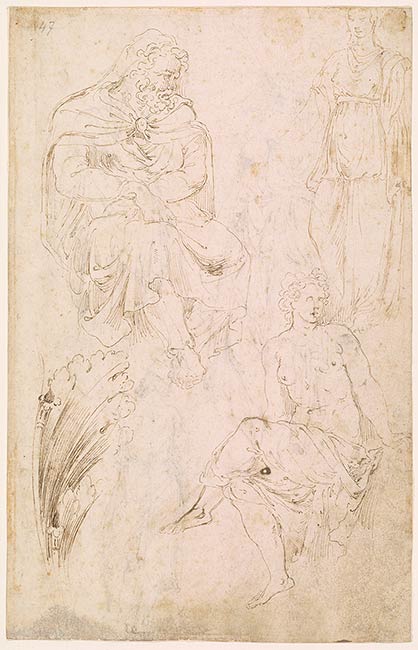

As indicated by an old inscription on the verso, the drawing has traditionally been given to Girolamo da Carpi, who is documented in Rome from 1549 to 1553, when he was looking after the antique statuary belonging to Cardinal Ippolito II d’Este. He is also thought to have visited Rome ca. 1524-25 and around 1531 (Dauner). During his later Roman years, Girolamo created hundreds of studies after the antique and copies of contemporary masters that possibly once constituted a single large sketchbook; large holdings of which are now in the Rosenbach collection in Philadelphia (85 sheets), the Biblioteca Reale, Turin (90 sheets), and the British Museum (five sheets; called group “A” by Gere and Pouncey). Further drawings in the British Museum, presumably from several sketchbooks, consist of works considered to be by a follower or followers—this latter set, called group “B” and “C” by Gere and Pouncey, contains numerous reprises.
Many of the motifs on the recto and verso of the Morgan sheet recur similarly in studies by Girolamo in Philadelphia, Turin, and the British Museum, as identified by Lia Markey. The seated bearded male on the upper left of the recto shows the Dacian prisoner, a sculpture once in Rome and now in the Louvre, Paris. A dry, quite schematic drawing of the same figure is in the British Museum sketchbook (Inv. 1946-7-13-308; Gere and Pouncey 1983, no. 161). The standing draped female wearing a chiton, at upper right, occurs in the Turin sketchbook, but without the addition of head and arm; the antique source has not been identified. The seated nymph pictured at lower right on the same side is part of a sculptural group once in the della Valle collection in Rome, and now in the Uffizi. The motif recurs in the Philadephia album, which presumably was the primary version. The source for the acanthus foliage at lower left is not known; a different spray of acanthus is depicted in both the Philadelphia and London albums. The caryatid on the verso, at upper left, may have been copied from the version in the Philadelphia album (R 44), though the artist of the Morgan sheet has adjusted the position of the lower arms so that both hands rest on the head. The female to the right of this is presumably a free adaptation of the draped female statue restored as Urania now in the Vatican museums and once in the villa d’Este on the Quirinal hill in Rome. The same sculpture occurs from a more sideways angle on a sheet in Philadelphia, without, however, the reversal of the legs, and missing the right arm (R 104).
The inscription “Carpi” occurs in a similar hand on one drawing (or possibly two) in the British Museum, given to a follower of Girolamo (group “C”), suggesting the sheets once formed part of the same sketchbook, and are possibly by the same hand (Inv. 5212-78 recto (and possibly Inv. 5210-67); Gere and Pouncey 1983, nos. 172 and 186. Gere and Pouncey 1983, nos. 172-185 classified as group “C” by Philip Pouncey and John Gere; see also 96-97). Whereas in Girolamo’s securely attributed drawings after the antique, the artist has concentrated on the folds of drapery, the artist of the Morgan sheet has generally outlined the figures, carefully “restoring” the sculptures represented by adding feet, toes and head. On balance it seems reasonable to assume the artist to have been either Girolamo himself, reprising earlier motifs, or an artist from his immediate circle with access to his studies.
Watermark: none.
Inscribed at upper left, in graphite, "47"; on verso, at lower left, in pen and brown ink, "Carpi".
Bellinger, Katrin, former owner.
Katalan, Jak, former owner.
Philadelphia 2005, 32, n. 2; 134, n. 5.
